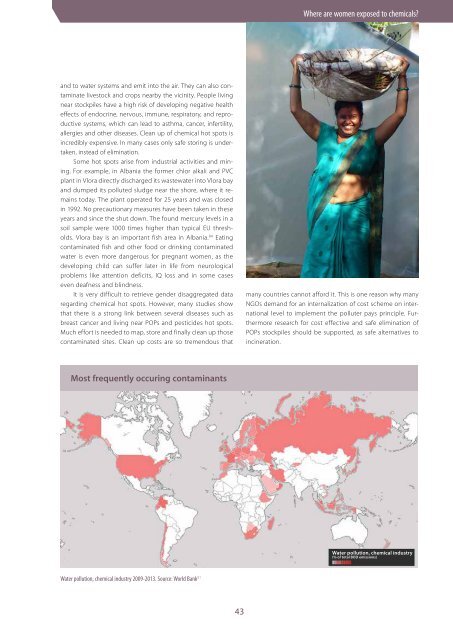Women and Chemicals
1ToENNR
1ToENNR
You also want an ePaper? Increase the reach of your titles
YUMPU automatically turns print PDFs into web optimized ePapers that Google loves.
Where are women exposed to chemicals?<br />
<strong>and</strong> to water systems <strong>and</strong> emit into the air. They can also contaminate<br />
livestock <strong>and</strong> crops nearby the vicinity. People living<br />
near stockpiles have a high risk of developing negative health<br />
effects of endocrine, nervous, immune, respiratory, <strong>and</strong> reproductive<br />
systems, which can lead to asthma, cancer, infertility,<br />
allergies <strong>and</strong> other diseases. Clean up of chemical hot spots is<br />
incredibly expensive. In many cases only safe storing is undertaken,<br />
instead of elimination.<br />
Some hot spots arise from industrial activities <strong>and</strong> mining.<br />
For example, in Albania the former chlor alkali <strong>and</strong> PVC<br />
plant in Vlora directly discharged its wastewater into Vlora bay<br />
<strong>and</strong> dumped its polluted sludge near the shore, where it remains<br />
today. The plant operated for 25 years <strong>and</strong> was closed<br />
in 1992. No precautionary measures have been taken in these<br />
years <strong>and</strong> since the shut down. The found mercury levels in a<br />
soil sample were 1000 times higher than typical EU thresholds.<br />
Vlora bay is an important fish area in Albania. 84 Eating<br />
contaminated fish <strong>and</strong> other food or drinking contaminated<br />
water is even more dangerous for pregnant women, as the<br />
developing child can suffer later in life from neurological<br />
problems like attention deficits, IQ loss <strong>and</strong> in some cases<br />
even deafness <strong>and</strong> blindness.<br />
It is very difficult to retrieve gender disaggregated data<br />
regarding chemical hot spots. However, many studies show<br />
that there is a strong link between several diseases such as<br />
breast cancer <strong>and</strong> living near POPs <strong>and</strong> pesticides hot spots.<br />
Much effort is needed to map, store <strong>and</strong> finally clean up those<br />
contaminated sites. Clean up costs are so tremendous that<br />
many countries cannot afford it. This is one reason why many<br />
NGOs dem<strong>and</strong> for an internalization of cost scheme on international<br />
level to implement the polluter pays principle. Furthermore<br />
research for cost effective <strong>and</strong> safe elimination of<br />
POPs stockpiles should be supported, as safe alternatives to<br />
incineration.<br />
Most frequently occuring contaminants<br />
Water pollution, chemical industry<br />
(% of total BOD emissions)<br />
Water pollution, chemical industry 2009-2013. Source: World Bank 81<br />
43


